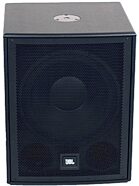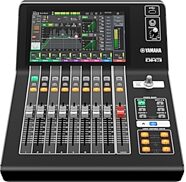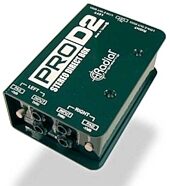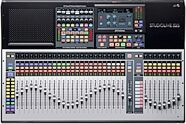Radial JDV MK3 Super Active DI Box
No longer available at zZounds
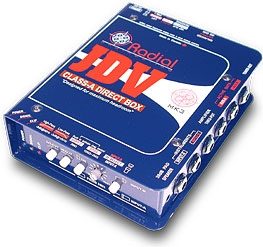


Transfer signals without distorting sound with this Radial active DI unit. It features Class-A feed-forward circuitry and 30V of internal rail power.
Overview
Radial's flagship direct box. Features a highly acclaimed Class-A feed-forward circuit design with huge 30V internal rail voltage for absolute no-compromise performance. The JDV Mk3 expands the functionality of regular direct boxes by providing a zoned working environment with 4 instrument outputs, in addition to the traditional balanced out. This allows unprecedented flexibility and creative setups.
- Huge 30-Volt internal rail voltage
- Innovative Drag control
- Variable impedance to 3.9 Meg-Ohms
- Unique zoned design concept
The Radial JDV Mk3 is arguably the most advanced and sonically superior direct box made today. With 100% class-A circuit and a 30-Volt internal rail voltage, the JDV combines exceptional sonic quality and unmatched dynamic handling for the most natural and uncolored sound possible.
Designed as a creative tool, the JDV introduces a concept of 'Zones' with choice of two inputs, four instrument amplifier outputs, and a unity-gain transformerless output.
Features include Drag control for precise pickup load correction, 3.9 meg-ohm input impedance for piezo pickups, hi-pass and lo-pass filters, full LED status indicators, polarity reverse and all of the other features one would expect from a Radial DI.
The Radial JDV Mk3 is designed for use in both the studio and live performance and is suitable for all instruments where added reach is required and retaining the original sound of the instrument without… read more distortion or coloration is paramount.
The Radial JDV Mk3 represents a milestone in direct box technology by introducing the concept of creative zones for the musician and engineer all the while elevating the sonic expectations beyond any other direct box produced today. Radial calls it the Super DI.
The Radial JDV was originally developed by John Vrtacic in the 1980s, who at the time was the Chief Technical Engineer for Little Mountain Studios in Vancouver, British Columbia. Little Mountain was 'home' to producers Bruce Fairbairn and Bob Rock and their astonishing number of hit records from artists like Aerosmith, Bryan Adams, AC/DC, The Cult, Metallica, Bon Jovi, Loverboy and so many others. The huge Little Mountain 'drum and bass sound' became famous with millions of albums sold worldwide.
In 1997, Ron 'Obvious' Vermulin, Chief Technical Engineer at Bryan Adams' Warehouse Studios (Ron also designed the Mutt Lange/Shania Twain studio) was asked to test the 1st generation Radial JDI passive direct boxes against a number of 'popular' DIs and it was from these tests that the Radial Green Report was produced. While testing the Radial JDI, Ron decided to run the same tests through one of the original John Vrtacic JDV direct boxes. Although the Radial JDI fared better than all other commercial units, the hand-made JDV was clearly the best. Ron suggested Radial contact John and build a commercially viable version of the JDV.
The first-generation Radial JDV gained a strong following due the clarity of tone. This was supported with it winning comparative tests in influential magazines such as Mix, Recording Magazine, and Bass Player. The JDV became firmly cemented in the industry when influential artists like Tony Levin, Will Lee and Alain Caron began using it on their bass tracks. The first-generation JDV employed a battery as part of the power supply circuit along with a switching power supply and surface mount technology. This was done in an attempt to reduce the size and power consumption. Although the system worked well, many users did not like to have to keep the internal batteries charged so in 2001, the decision was made to update and redesign the JDV.
The Radial JDV Mk3 is their most advanced DI ever. Radial calls it the Super-DI because it combines the amazing sound of the original with a significantly improved power supply, a very low noise floor and a tremendously useful feature set.
The JDV is actually designed to be a creative tool. By providing an array of connecting options, the intent is to open the door to sounds and spur on the creative process of making music. Now isn't that what a good interface should be?
- 80 Hz high-pass filter reduces excessive bass for more clarity. Elliminates run-away resonant feedback from acoustics.
- 7 kHz low-pass filter gently rolls off high end edge and reduces noise and hiss from older instruments.
- Vary-Z switch selects between ultra-high 3.9 Meg-Ohm input impedance and Drag control for load correction.
- Drag Control is used to retain the natural feel of the instrument on the active auxiliary outputs by correcting the load.
- A or B input switch selects between the two instruments inputs for fast changes.
The Radial JDV begins with an input selector for choice between two instruments. Often, when recording, the simple act of picking up another instrument will cause the musician to play a passage differently and often, this change can lead to magical results. In concert, being able to pick-up a spare or alternately tuned instrument without having to reconnect is a joy.
On the left, three LED indicators provide power-on, signal present and overload status. Two onboard filters are provided. A low-cut filter (high-pass filter) is used to reduce rumble and run-away resonant feedback from acoustic instruments. For bass, this will tighten up the bottom end without losing the fundamental. A high frequency roll-off (low-pass filter) gently rolls off noise from older equipment and helps tame overly brittle instruments.
The JDV Mk3 includes a special feature Radial developed called Drag Control. This function was originally developed on the Radial JD7 Injector as a means to re-introduce the loading that is lost when the guitar pick-up no longer is coupled directly to the amplifier. Laboratory engineers have perpetuated a 'myth' that 'loading the pick-up' is a bad thing when in fact, correcting the load is critical to achieving musical results. Without proper impedance matching, the sound can become brittle and harsh. This of course is most noticeable when recording.
The JDV offers a choice of a 3.9 Meg-ohm input impedance (the highest in the industry) to properly match piezo pickups and variable loading Radial calls Drag Control that combines resistance and impedance with a single dial for effective load correction.
- Speaker interface option introduces a -30dB input pad. Must be connected in parallel w/speaker.
- Inputs A & B are selected using front panel switch for quick. noiseless instrument change.
- Direct thru-put passive output connects to the instrument amplifier.
- Auxiliary outputs A & B are used for additional amplifiers, stereo rigs or effect devices.
- Tuner output removes tuner from audio signal path for optimum audio performance.
- No-slip full bottom pad reduces mechanical vibration, improves electrical isolation & stops sliding.
All instrument thru-put connections are performed on the side panel thus keeping cables out of the way from the controls and LED status indicators. Inputs A and B are adjacent to the direct output. There are two Class-A active outputs termed aux-A and aux-B that can drive two amplifiers, a stereo effect device or effect pedals. A tuner out allows the instrument to be constantly monitored while ensuring the tuner circuit and load does not affect the instrument's signal integrity.
The unique array of inputs and outputs is designed to provide the artist with a creative zone or environment. There is nothing more musically satisfying than feeling as if you are inside the instrument, completely surrounded by sound.
A speaker input pad selector switch allows a parallel connection to a speaker cabinet to get the post amplifier sound such as from a distorted guitar. The selector pad is purposely difficult to engage as a means to protect the JDV from the accidental insertion of a post amplifier signal without a speaker load.
- Strain relief for power supply cable.
- XLR balanced mic level output can drive runs of up to 1000 feet without appreciable noise.
- Polarity reverse switch flips the polarity from the AES standard Pin-2 to Pin-3 on the XLR and is used when combining sounds that may be out of phase.
- -15 dB pad: The JDV rail voltage is so huge, Radial put a -15 dB pad at the output so that it will not overload your mixer.
- Ground-lift disconnects the ground path at the XLR output. This would be used when a ground connection is made at the input side such as with a keyboard.
- 42V external DC power supply with cable lock to assure the JDV will not accidentally lose its power connection.
The output panel is the engineer's zone. The XLR output provides a clean, unaffected signal to the console for future processing or doubling with the mic'ed performance. Because of the JDV's huge internal rail voltage and exceptional dynamic handling, an output pad is provided so that it will not overload the console or pre-amp. A polarity reverse switches the XLR output from AES standard pin-2 hot to pin-3 to adapt to vintage equipment while providing another creative tool to broaden the audio landscape.
To achieve this level of audio purity, every aspect of the Radial JDV's circuit must be optimized for minimal distortion. And unlike other manufacturers, Radial does not just examine harmonic distortion, but zealously try to eliminate zero-cross distortion, phase distortion, inter-modulation distortion, linear response distortion, square wave distortion and headroom. By treating each of these carefully, the result is predictable: you get great sound.
The Radial JDV employs a unique Class-A feed-forward circuit design and an upgraded high-voltage, low-noise power supply. Class-A circuits although less efficient, do not suffer from zero-cross distortion. This is why Class-A circuits are 'the choice' for audiophiles. The JDV's unique feed-forward design means that Radial has eliminated the traditional stabilizing feedback loop that is in the 'easy circuit designer's handbook'. This unique 'high-wire without a net' circuit design is amazingly adept at handling square 'pulse' waves without ringing or overshoot. Put the JDV up on a scope and one will see a sharp, 90 degree rendering that is unequaled in the business.
The exceptional internal 30-Volt rail voltage is of particular importance at bass frequencies. In PA systems, bass drivers are commonly driven with as much as ten times more power than the high-frequency drivers. This is because bass, with its longer wavelengths, requires significantly more power to generate. This is the same at the circuit level and is critical to achieving a tight, natural sound. Look inside the JDV and you will see huge current storage capacitors that are the size found in small power amplifiers. By providing ample impulse energy storage, dynamics are maximized thus fulfilling the capacity of today's most advanced recording devices. The benefit of having upwards to 10 times more headroom than a traditional DI means that the JDV never chokes even with the most powerful active bass or extreme digital sample.
- I-beam construction eliminates external stresses on PC board.
- 42-Volt power supply input jack.
- Cable lock strain relief prevents power loss from accidental unplugging.
- Large, oversized capacitors for maximum headroom.
- 100% Class-A discreet circuitry (no op-amps).
- Baked enamel finish for added durability.
Like all Radial products, the JDV is built to last. A unique book-end design provides easy access to switches, knobs and jacks while providing a protective barrier against abuse. Inside, the JDV employs a folded I-beam construction that makes impossible to torque the PC board. This eliminates stress on the solder joints and pretty much eliminates servicing problems. The distinctive dark-blue baked enamel finish resists scratching while also making the JDV relatively invisible under cameras and stage lights. Finally, a full-bottom no-slip rubberized pad provides both shock mounting and staying power to keep the JDV in one place.
Using the JDV is the same as any other direct box. Connect the instrument to the input, the amplifier output to the amplifier and the XLR balanced output to the mixer or pre-amp. The XLR output is 'mic level' to allow the JDV to be used in snake systems with microphones and splitters. One should note that since the JDV is a 'unity gain' device, driving a high level signal into the JDV will result in a high level at the output. This may exceed the capacity of the microphone input levels. To protect against overload, a 15dB pad at the output is provided.
The real fun with the JDV starts when multi-amp set-ups are created and recording the combination of direct and mic'ed signals are realized. For a full description of functions, the Radial JDV owner's manual should be perused.
Features:
- Class-A feed forward design- Huge 30-Volt internal rail voltage
- Innovative Drag control
- Variable impedance to 3.9 Meg-Ohms
- Unique zoned design concept
The Radial JDV Mk3 is arguably the most advanced and sonically superior direct box made today. With 100% class-A circuit and a 30-Volt internal rail voltage, the JDV combines exceptional sonic quality and unmatched dynamic handling for the most natural and uncolored sound possible.
Designed as a creative tool, the JDV introduces a concept of 'Zones' with choice of two inputs, four instrument amplifier outputs, and a unity-gain transformerless output.
Features include Drag control for precise pickup load correction, 3.9 meg-ohm input impedance for piezo pickups, hi-pass and lo-pass filters, full LED status indicators, polarity reverse and all of the other features one would expect from a Radial DI.
The Radial JDV Mk3 is designed for use in both the studio and live performance and is suitable for all instruments where added reach is required and retaining the original sound of the instrument without… read more distortion or coloration is paramount.
JDV Development and Evolution
For years, the direct box has been seen as simple impedance matching and balancing device that would allow an instrument signal to travel long distances without adding appreciable noise. With the advent of 24-bit/96 kHz recording, unlimited real or virtual tracks, multi-channel surround monitoring systems, and the constant evolution of instrument amplification and effects, opportunities have blossomed which have imposed the reevaluation of the traditional direct box.The Radial JDV Mk3 represents a milestone in direct box technology by introducing the concept of creative zones for the musician and engineer all the while elevating the sonic expectations beyond any other direct box produced today. Radial calls it the Super DI.
The Radial JDV was originally developed by John Vrtacic in the 1980s, who at the time was the Chief Technical Engineer for Little Mountain Studios in Vancouver, British Columbia. Little Mountain was 'home' to producers Bruce Fairbairn and Bob Rock and their astonishing number of hit records from artists like Aerosmith, Bryan Adams, AC/DC, The Cult, Metallica, Bon Jovi, Loverboy and so many others. The huge Little Mountain 'drum and bass sound' became famous with millions of albums sold worldwide.
In 1997, Ron 'Obvious' Vermulin, Chief Technical Engineer at Bryan Adams' Warehouse Studios (Ron also designed the Mutt Lange/Shania Twain studio) was asked to test the 1st generation Radial JDI passive direct boxes against a number of 'popular' DIs and it was from these tests that the Radial Green Report was produced. While testing the Radial JDI, Ron decided to run the same tests through one of the original John Vrtacic JDV direct boxes. Although the Radial JDI fared better than all other commercial units, the hand-made JDV was clearly the best. Ron suggested Radial contact John and build a commercially viable version of the JDV.
The first-generation Radial JDV gained a strong following due the clarity of tone. This was supported with it winning comparative tests in influential magazines such as Mix, Recording Magazine, and Bass Player. The JDV became firmly cemented in the industry when influential artists like Tony Levin, Will Lee and Alain Caron began using it on their bass tracks. The first-generation JDV employed a battery as part of the power supply circuit along with a switching power supply and surface mount technology. This was done in an attempt to reduce the size and power consumption. Although the system worked well, many users did not like to have to keep the internal batteries charged so in 2001, the decision was made to update and redesign the JDV.
The Radial JDV Mk3 is their most advanced DI ever. Radial calls it the Super-DI because it combines the amazing sound of the original with a significantly improved power supply, a very low noise floor and a tremendously useful feature set.
The JDV Mk3's 'Zones' concept
The purpose of the Radial JDV is to provide the user with the very best interface between the instrument and the recording or sound reinforcement system. Today, the 'instrument' is not just the guitar, bass, or contrabass, but the instrument in combination with the amplifier, effect rack and pedals. In order to effectively capture the complete sound, the very fabric of the direct box was revisited. The artist, whether guitarist or bassist, will usually have more than one instrument and a variety of outboard effects and amplifiers that make up his or her sound. This is his environment, her comfort zone, their creative world. The engineer and producer may want to record this sound by traditionally miking the amplifiers, but with today's advanced editing equipment and re-amping tools like the Radial JD7 or Radial X-amp, simultaneously recording the clean unaltered source is now an essential part of the recording process. Thus the concept of zones was developed: An input zone for the instrument, the musician's zone for his creative environment, and an output zone for the engineer.The JDV is actually designed to be a creative tool. By providing an array of connecting options, the intent is to open the door to sounds and spur on the creative process of making music. Now isn't that what a good interface should be?
Instrument Input Zone
- LED Status indicators include system on, signal present and peak level overload.- 80 Hz high-pass filter reduces excessive bass for more clarity. Elliminates run-away resonant feedback from acoustics.
- 7 kHz low-pass filter gently rolls off high end edge and reduces noise and hiss from older instruments.
- Vary-Z switch selects between ultra-high 3.9 Meg-Ohm input impedance and Drag control for load correction.
- Drag Control is used to retain the natural feel of the instrument on the active auxiliary outputs by correcting the load.
- A or B input switch selects between the two instruments inputs for fast changes.
The Radial JDV begins with an input selector for choice between two instruments. Often, when recording, the simple act of picking up another instrument will cause the musician to play a passage differently and often, this change can lead to magical results. In concert, being able to pick-up a spare or alternately tuned instrument without having to reconnect is a joy.
On the left, three LED indicators provide power-on, signal present and overload status. Two onboard filters are provided. A low-cut filter (high-pass filter) is used to reduce rumble and run-away resonant feedback from acoustic instruments. For bass, this will tighten up the bottom end without losing the fundamental. A high frequency roll-off (low-pass filter) gently rolls off noise from older equipment and helps tame overly brittle instruments.
The JDV Mk3 includes a special feature Radial developed called Drag Control. This function was originally developed on the Radial JD7 Injector as a means to re-introduce the loading that is lost when the guitar pick-up no longer is coupled directly to the amplifier. Laboratory engineers have perpetuated a 'myth' that 'loading the pick-up' is a bad thing when in fact, correcting the load is critical to achieving musical results. Without proper impedance matching, the sound can become brittle and harsh. This of course is most noticeable when recording.
The JDV offers a choice of a 3.9 Meg-ohm input impedance (the highest in the industry) to properly match piezo pickups and variable loading Radial calls Drag Control that combines resistance and impedance with a single dial for effective load correction.
Musician's Connection Zone
- Heavy-duty baked enamel finish for durability and great looks. 14-gauge steel makes it impossible to break.- Speaker interface option introduces a -30dB input pad. Must be connected in parallel w/speaker.
- Inputs A & B are selected using front panel switch for quick. noiseless instrument change.
- Direct thru-put passive output connects to the instrument amplifier.
- Auxiliary outputs A & B are used for additional amplifiers, stereo rigs or effect devices.
- Tuner output removes tuner from audio signal path for optimum audio performance.
- No-slip full bottom pad reduces mechanical vibration, improves electrical isolation & stops sliding.
All instrument thru-put connections are performed on the side panel thus keeping cables out of the way from the controls and LED status indicators. Inputs A and B are adjacent to the direct output. There are two Class-A active outputs termed aux-A and aux-B that can drive two amplifiers, a stereo effect device or effect pedals. A tuner out allows the instrument to be constantly monitored while ensuring the tuner circuit and load does not affect the instrument's signal integrity.
The unique array of inputs and outputs is designed to provide the artist with a creative zone or environment. There is nothing more musically satisfying than feeling as if you are inside the instrument, completely surrounded by sound.
A speaker input pad selector switch allows a parallel connection to a speaker cabinet to get the post amplifier sound such as from a distorted guitar. The selector pad is purposely difficult to engage as a means to protect the JDV from the accidental insertion of a post amplifier signal without a speaker load.
Engineer's Output Zone
- Unique book-end design creates a protective boundary around the switches and connectors.- Strain relief for power supply cable.
- XLR balanced mic level output can drive runs of up to 1000 feet without appreciable noise.
- Polarity reverse switch flips the polarity from the AES standard Pin-2 to Pin-3 on the XLR and is used when combining sounds that may be out of phase.
- -15 dB pad: The JDV rail voltage is so huge, Radial put a -15 dB pad at the output so that it will not overload your mixer.
- Ground-lift disconnects the ground path at the XLR output. This would be used when a ground connection is made at the input side such as with a keyboard.
- 42V external DC power supply with cable lock to assure the JDV will not accidentally lose its power connection.
The output panel is the engineer's zone. The XLR output provides a clean, unaffected signal to the console for future processing or doubling with the mic'ed performance. Because of the JDV's huge internal rail voltage and exceptional dynamic handling, an output pad is provided so that it will not overload the console or pre-amp. A polarity reverse switches the XLR output from AES standard pin-2 hot to pin-3 to adapt to vintage equipment while providing another creative tool to broaden the audio landscape.
The JDV Audio Path
The most important feature of the Radial JDV is the sound quality. At Radial, Radial prides themselves in the fact that their direct boxes do not change the original sound or impose a particular EQ curve to an instrument. Radial does not believe it is their place to alter the sound of pre-CBS Fender or a PAF equipped Gibson. Their task is to provide the original sound of the instrument without adding color, distortion or hype. Radial calls their sound the Un-Sound.To achieve this level of audio purity, every aspect of the Radial JDV's circuit must be optimized for minimal distortion. And unlike other manufacturers, Radial does not just examine harmonic distortion, but zealously try to eliminate zero-cross distortion, phase distortion, inter-modulation distortion, linear response distortion, square wave distortion and headroom. By treating each of these carefully, the result is predictable: you get great sound.
The Radial JDV employs a unique Class-A feed-forward circuit design and an upgraded high-voltage, low-noise power supply. Class-A circuits although less efficient, do not suffer from zero-cross distortion. This is why Class-A circuits are 'the choice' for audiophiles. The JDV's unique feed-forward design means that Radial has eliminated the traditional stabilizing feedback loop that is in the 'easy circuit designer's handbook'. This unique 'high-wire without a net' circuit design is amazingly adept at handling square 'pulse' waves without ringing or overshoot. Put the JDV up on a scope and one will see a sharp, 90 degree rendering that is unequaled in the business.
The exceptional internal 30-Volt rail voltage is of particular importance at bass frequencies. In PA systems, bass drivers are commonly driven with as much as ten times more power than the high-frequency drivers. This is because bass, with its longer wavelengths, requires significantly more power to generate. This is the same at the circuit level and is critical to achieving a tight, natural sound. Look inside the JDV and you will see huge current storage capacitors that are the size found in small power amplifiers. By providing ample impulse energy storage, dynamics are maximized thus fulfilling the capacity of today's most advanced recording devices. The benefit of having upwards to 10 times more headroom than a traditional DI means that the JDV never chokes even with the most powerful active bass or extreme digital sample.
- I-beam construction eliminates external stresses on PC board.
- 42-Volt power supply input jack.
- Cable lock strain relief prevents power loss from accidental unplugging.
- Large, oversized capacitors for maximum headroom.
- 100% Class-A discreet circuitry (no op-amps).
- Baked enamel finish for added durability.
Like all Radial products, the JDV is built to last. A unique book-end design provides easy access to switches, knobs and jacks while providing a protective barrier against abuse. Inside, the JDV employs a folded I-beam construction that makes impossible to torque the PC board. This eliminates stress on the solder joints and pretty much eliminates servicing problems. The distinctive dark-blue baked enamel finish resists scratching while also making the JDV relatively invisible under cameras and stage lights. Finally, a full-bottom no-slip rubberized pad provides both shock mounting and staying power to keep the JDV in one place.
Using the JDV
The JDV employs an external power supply as 48V phantom power is unable to provide sufficient current. The convenient in-line type power supply reduces clutter at the A/C source and is easy to position away from signal carrying cables to reduce induction. A cable lock is provided to ensure the power supply is not accidentally disconnected.Using the JDV is the same as any other direct box. Connect the instrument to the input, the amplifier output to the amplifier and the XLR balanced output to the mixer or pre-amp. The XLR output is 'mic level' to allow the JDV to be used in snake systems with microphones and splitters. One should note that since the JDV is a 'unity gain' device, driving a high level signal into the JDV will result in a high level at the output. This may exceed the capacity of the microphone input levels. To protect against overload, a 15dB pad at the output is provided.
The real fun with the JDV starts when multi-amp set-ups are created and recording the combination of direct and mic'ed signals are realized. For a full description of functions, the Radial JDV owner's manual should be perused.
Summary
The Radial JDV Super DI is truly an innovative product that lives up to its name. With its unique Class-A feed-forward circuit design and high internal rail voltage, it produces exceptional dynamic handling without introducing distortion or color. It features a full compliment of input and output connections to present greater creative options, all the while retaining the original sound that has made the JDV one of the most highly acclaimed and recorded direct boxes of all time. read lessSpecs
Frequency Response: 10 Hz - 30 kHz (+/- 1 dB)
Residual Noise: -93 dB @ 1V-RMS
Distortion (20 Hz - 20 kHz): < 0.015% @ 1V RMS (1.2 kOhm load)
< 0.5% @ 5V RMS (without load)]
Phase Deviation: < 5 degrees @ 100 Hz
Intermodulation Distortion: 0.07% (DIN Standard)
Output Impedance: 600 Ohms
Input Pad (speaker): -30 dB
Output Pad: -15 dB
Power Requirement: Custom 30V supply
Residual Noise: -93 dB @ 1V-RMS
Distortion (20 Hz - 20 kHz): < 0.015% @ 1V RMS (1.2 kOhm load)
< 0.5% @ 5V RMS (without load)]
Phase Deviation: < 5 degrees @ 100 Hz
Intermodulation Distortion: 0.07% (DIN Standard)
Output Impedance: 600 Ohms
Input Pad (speaker): -30 dB
Output Pad: -15 dB
Power Requirement: Custom 30V supply
No longer available at zZounds
In most cases, a product is unavailable because it has been discontinued by the manufacturer
This is a carousel with product cards. Use the previous and next buttons to navigate.



